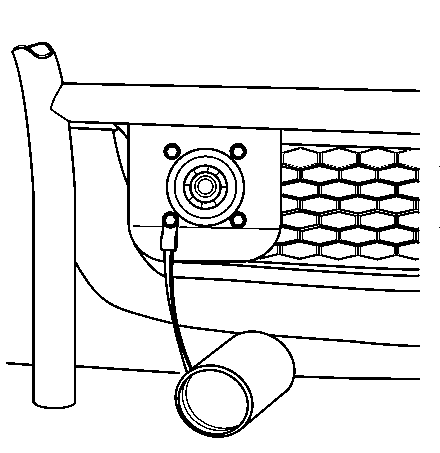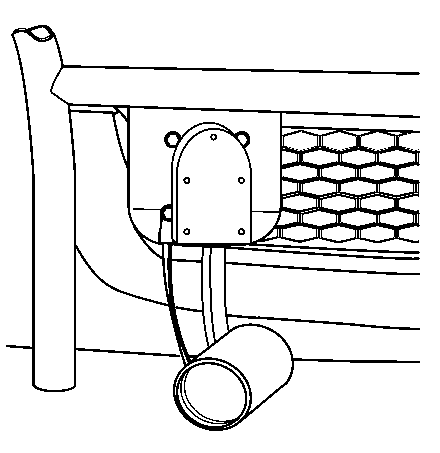Slave Starting 24V NATO Connector
If the battery (or batteries) on the vehicle have run down and the vehicle will not start, you may want to use another vehicle to provide power to start the vehicle.
NATO slave cables are the only recommended method for 24-volt jump starting of the vehicle. You should only use NATO slave cables to jump start similar vehicles.
Caution: Batteries can hurt you. They can be dangerous because:
• They contain acid that can burn you. • They contain gas that can explode or ignite. • They contain enough electricity to burn you.
Notice: Ignoring these steps could result in costly damage to the vehicle that would not be covered by the warranty.
Trying to start the vehicle by pushing or pulling it will not work, and it could damage the vehicle.You should only use the NATO slave receptacle and slave cable when performing this operation.
- Check the other vehicle. It must have a 24-volt battery with a negative ground.
- Get the vehicles close enough so that the slave cable can reach, but be sure the vehicles are not touching each other. If they are, it could cause a ground connection causing the vehicle not to start, and the bad grounding could damage the electrical systems.
- Turn off the ignition on both vehicles. Unplug unnecessary accessories plugged into the cigarette lighter or accessory power outlets. Turn off all lamps that are not required as well as radios. This will avoid sparks and help save both batteries. In addition, it could save the radio!
- Locate the slave receptacles on both vehicles and unscrew the cover.
- Connect the slave cable to the vehicle with the dead battery.
- Connect the slave cable to the vehicle with the good battery.
- Start the vehicle with the good battery.
- Allow the vehicle with the dead battery to charge for 10 minutes.
- Start the vehicle with the dead battery.
- Note: Use twisting motion when disconnecting slave cable from the receptacle. Forcefully pulling the cable from the receptacle may cause damage to the receptacle mount.
- Install the covers on both vehicles and fully tighten to ensure a proper seal.
- Clean and stow the slave cable.
To avoid the possibility of the vehicles rolling, set the parking brake firmly on both vehicles involved in the jump start procedure. Put the automatic transmission in PARK (P). Be sure the transfer case is in a drive gear and is NOT in NEUTRAL (N).
Notice: If you leave the communications/navigation equipment or other accessories on during jump starting procedure, they could be damaged. The repairs wouldn’t be covered by the warranty. Always turn off your communications/navigation equipment or other accessories when jump starting your vehicle.

Caution: Using an open flame near a battery can cause battery gas to explode. People have been hurt doing this, and some have been blinded. Use a flashlight if you need more light. Be sure the batteries have enough water. You don’t need to add water to the Optima battery (or batteries) installed in every new Military vehicle. But if a battery has filler caps, be sure the right amount of fluid is there. If it is low, add water to take care of that first. If you do not, explosive gas could be present. Battery fluid contains acid that can burn you. Do not get it on you. If you accidentally get it in the eyes or on the skin, flush the place with water and get medical help immediately.
Caution: Fans or other moving engine parts can injure you badly. Keep your hands away from moving parts once the engine is running.
Note: Use twisting motion when installing slave cable to the receptacle. Forcefully pushing the cable onto the receptacle may cause damage to the receptacle mount.

Note: Use twisting motion when installing slave cable to the receptacle. Forcefully pushing the cable onto the receptacle may cause damage to the receptacle mount.
Note: It may take up to 30 minutes to charge the battery enough to start the vehicle, depending on the battery’s state of charge.
Remove the slave cable in the reverse order that it was installed. Take care not to let the cable ends touch each other or any other metal.
